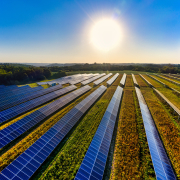AgriSolar News Roundup: Wyoming Solar Grazing, French Agrisolar Study, Bipartisan Agrisolar Support
$500 Million Solar Grazing Site to be Constructed in Wyoming
“A proposed solar farm near Glenrock will cover 4,738 acres on land bordering the North Platte River, the equivalent of more than 3,500 football fields. When online, it will provide 500 megawatts of solar power and include two battery storage facilities. And there will still be room for the land to support a sheep-grazing operation after construction.
The $500 million project is scheduled to begin construction in March 2024, and if all goes as planned, will come online in July 2026. The project will be built entirely on private land, and Willox said the developer and landowner have agreed to allow sheep grazing underneath the panels.” – cowboystatedaily
French Study Shows Benefits of Agrisolar in Water Resource Management
“France’s Sun’Agri has revealed the results of a test showing how agrivoltaic installations effectively lower temperature and relative humidity during periods of drought. Amidst an ongoing heatwave in southern France, Sun’Agri, a French agrivoltaics specialist, has released its latest findings on the impacts of its technology on water resource management.
The company conducted an analysis on the effects of solar panels on apple, cherry, and nectarine trees across three sites in La Pugère, Etoile sur Rhône, and Loriol, southern France. The study demonstrated that the PV installations reduced temperature and increased relative humidity for the crops underneath the panels during hot weather, compared to reference areas without protection.” – PV Magazine
New Bill Shows Bipartisan Support for Agrisolar Development
“The latest demonstration of bipartisan support for agrivoltaics comes from the offices of US Senators Martin Heinrich of New Mexico and Mike Braun of Indiana. They introduced the new Agrivoltaics Research and Demonstration Act of 2023 in the Senate on May 31.
This bill will research agrivoltaics — solar panel systems that can be deployed over crops that can benefit from partial shading during the day — and how they can help farmers get more out of their fields.” – Cleantechnica


